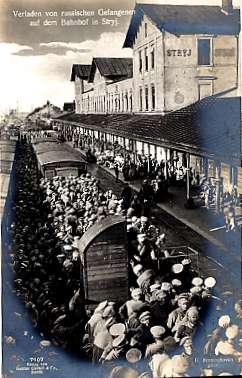Mars has his way
Almost every new technology,. especially transportation technologies, has done their share to occasionally increase the volume of human misery in the world. Its hard to imagine the trenches of ww1, with the ceaseless supply of bullets and bodies, without the emerging efficiency of steam and rail. Or the civilian airliners of WW2 in their new role as bombers bringing ever larger numbers of civilians within the scope of total war. Frankly, what more autonomous vehicles enable?
It is important to note that the bloodshed described above is as much about removing existing limits on man's ability to wage war as it is about creating new ways to kill. Trains removed many of the limitations that distance, and seasons, imposed on warring armies. Bombers alleviated the limits physics imposed on the travel of munitions beyond the front lines. The question then remains, are there serious limits to our ability to wage war that still remain? And if so, does the automation of transportation threaten to reduce or eliminate some of those limits? The modern economies great advantage in war-the production line. its great disadvantage-the consumer (as soldier). The driverless vehicle, and robots in general, are about to free the former from the latter.
Only Russia in WW2, with its huge production capacity and massive (largely consumer free) population has ever really explored this potential. The USA did something similar by turning its capacity over to its allies.......
reduce casualties
insurgencies-play to our strengths (they provide us with targets that cost them little(people), lets provide them with targets that cost us little (cars)
Limits are often the first to fall in the face of technological change, along with the soldiers that counted on those limits to protect them from the ravages of war.
Robots in general are finding their way onto the battlefield in increasing numbers . What is really needed, by aid organizations, development teams, as well as the military, is the ability to move equipment and personnel quickly and safely over territory that is, if not overtly hostile, still unpredictable and threatening. Recent demonstrations of autonomous vehicle technology by DARPA were in fact an attempt to respond to those needs, by developing a technology that might allow re-supply of forces over hostile terrain without exposing transport personnel to attack.
Presently the focus is on creating a vehicle that will be able to navigate broken terrain and survive most direct attacks. The likely result will be a heavy, heavily armored, and very expensive vehicle. It will resemble a tank more then truck. Not a very effective response to an initiative that seeks to limit the danger to truck drivers, in an army that already has more tanks than it knows what to do with.
A more effective approach, both economically and militarily might be to combine what are now two separate and important tasks for the pacification of hostile territory—re-supply and road-building —into a single engineering challenge. Light-weight prefabricated roadway, light enough to be largely elevated above existing roadways and geographical elements, could be deployed quickly, ideally in a semi-automated fashion, across the landscape. On the roads would travel great numbers of lightweight autonomous vehicles of uniform appearance, giving no hint as to their contents or identity of their occupants. Whether military supplies, school books, civilian or military personal, the essential security would come from numbers and anonymity. For those actually carrying personnel there might be any number of protective devices built in, especially as the computers controlling their actions would be able to respond to threats almost instantaneously. And any number of the vehicles might be armed or decoys, or both. Unlike railways, where the engine itself is a high-value target, and its destruction often results in the loss of an entire train, an autonomous network would harness the developed worlds ability to produce numberless cars as a military advantage. It would be the first logistical system that becomes fundamentally less vulnerable to attack the larger and more complex it becomes.
Right now the forces in Afghanistan are pursuing a strategy of road building as the essential means of pacification in Afghanistan. It is a sound strategy, but very expensive. One of its strongest elements is that it is easiest to spot bombs planted in a nice solid piece of pavement. A lightweight road, especially if elevated, would possess the same quality. Additionally, the presence of large numbers of automated vehicles would allow for regular surveillance of the road. The insurgents would be faced with multiple targets of unknown value—many of them booby trapped—as well as a significant chance of detection during attempted sabotage. The solution of the logistical problem would be significant in itself, the impact on aid delivery and internal communication, economic development etc, might be profound.
There are of course more terrible functions this technology might perform in wartime. The most fundamental, and the on shared with all great advances in transportation technology, lies in its ability to transport the materials and weapons of war to the battlefield in ever greater numbers and at higher speed. The effect the railroad has had on the logistics of battle has already been described and it is hard to speculate about what the effects of a smaller, more flexible, and more resilient system would have on the conduct of war. Most of this impact would be in the far future, however, and will be discussed along with the even more frightening implications for warfare in a later section.
It’s hard to point to a technology that has ever been developed without finding itself at the service of Mars, if not largely developed under his patronage.
It is important to note that the bloodshed described above is as much about removing existing limits on man's ability to wage war as it is about creating new ways to kill. Trains removed many of the limitations that distance, and seasons, imposed on warring armies. Bombers alleviated the limits physics imposed on the travel of munitions beyond the front lines. The question then remains, are there serious limits to our ability to wage war that still remain? And if so, does the automation of transportation threaten to reduce or eliminate some of those limits? The modern economies great advantage in war-the production line. its great disadvantage-the consumer (as soldier). The driverless vehicle, and robots in general, are about to free the former from the latter.
Only Russia in WW2, with its huge production capacity and massive (largely consumer free) population has ever really explored this potential. The USA did something similar by turning its capacity over to its allies.......
Quick history of logistics transforming warfare
insurgencies-play to our strengths (they provide us with targets that cost them little(people), lets provide them with targets that cost us little (cars)
Limits are often the first to fall in the face of technological change, along with the soldiers that counted on those limits to protect them from the ravages of war.
Robots in general are finding their way onto the battlefield in increasing numbers . What is really needed, by aid organizations, development teams, as well as the military, is the ability to move equipment and personnel quickly and safely over territory that is, if not overtly hostile, still unpredictable and threatening. Recent demonstrations of autonomous vehicle technology by DARPA were in fact an attempt to respond to those needs, by developing a technology that might allow re-supply of forces over hostile terrain without exposing transport personnel to attack.
Presently the focus is on creating a vehicle that will be able to navigate broken terrain and survive most direct attacks. The likely result will be a heavy, heavily armored, and very expensive vehicle. It will resemble a tank more then truck. Not a very effective response to an initiative that seeks to limit the danger to truck drivers, in an army that already has more tanks than it knows what to do with.
A more effective approach, both economically and militarily might be to combine what are now two separate and important tasks for the pacification of hostile territory—re-supply and road-building —into a single engineering challenge. Light-weight prefabricated roadway, light enough to be largely elevated above existing roadways and geographical elements, could be deployed quickly, ideally in a semi-automated fashion, across the landscape. On the roads would travel great numbers of lightweight autonomous vehicles of uniform appearance, giving no hint as to their contents or identity of their occupants. Whether military supplies, school books, civilian or military personal, the essential security would come from numbers and anonymity. For those actually carrying personnel there might be any number of protective devices built in, especially as the computers controlling their actions would be able to respond to threats almost instantaneously. And any number of the vehicles might be armed or decoys, or both. Unlike railways, where the engine itself is a high-value target, and its destruction often results in the loss of an entire train, an autonomous network would harness the developed worlds ability to produce numberless cars as a military advantage. It would be the first logistical system that becomes fundamentally less vulnerable to attack the larger and more complex it becomes.
Right now the forces in Afghanistan are pursuing a strategy of road building as the essential means of pacification in Afghanistan. It is a sound strategy, but very expensive. One of its strongest elements is that it is easiest to spot bombs planted in a nice solid piece of pavement. A lightweight road, especially if elevated, would possess the same quality. Additionally, the presence of large numbers of automated vehicles would allow for regular surveillance of the road. The insurgents would be faced with multiple targets of unknown value—many of them booby trapped—as well as a significant chance of detection during attempted sabotage. The solution of the logistical problem would be significant in itself, the impact on aid delivery and internal communication, economic development etc, might be profound.
There are of course more terrible functions this technology might perform in wartime. The most fundamental, and the on shared with all great advances in transportation technology, lies in its ability to transport the materials and weapons of war to the battlefield in ever greater numbers and at higher speed. The effect the railroad has had on the logistics of battle has already been described and it is hard to speculate about what the effects of a smaller, more flexible, and more resilient system would have on the conduct of war. Most of this impact would be in the far future, however, and will be discussed along with the even more frightening implications for warfare in a later section.
It’s hard to point to a technology that has ever been developed without finding itself at the service of Mars, if not largely developed under his patronage.









Comments
Post a Comment